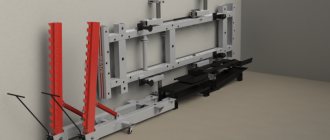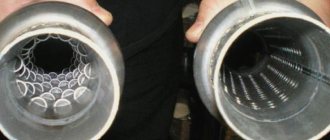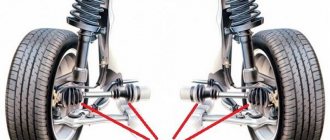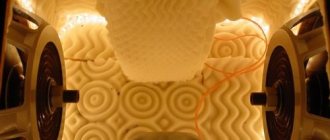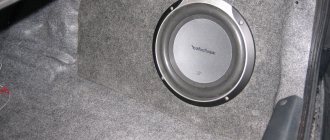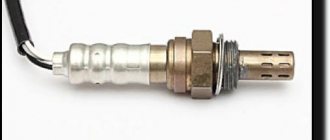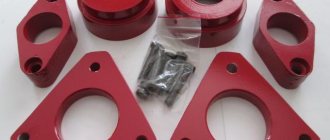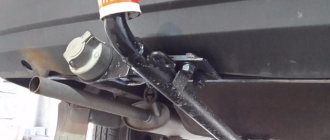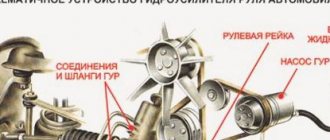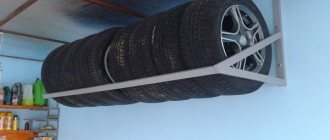On our forum, and on the forums of our auto repair friends, questions constantly come up about making a slipway for body repair in your garage. Many people try to make it with their own hands, but sometimes new knowledge is required, solutions to possible errors are required, and they have to seek help from their colleagues.
Usually two versions of homemade stocks are considered: mobile and stationary (concrete floor).
In this article, I tried to compile useful information from our forum, including: tips, drawings, photographs on making a slipway and to give an impetus to those who are not yet completely confident in their abilities and are afraid to start making it on their own.
Types of slipways and their main differences
There are 4 types of design:
- Floor-standing. Standard rail mounted design.
- Roll-on. Small in size. Such structures are stored in a garage or workshop.
- Frame. Structures on chains designed for complete repairs and lifting the machine to a height.
- Platform. Designed for professional repairs. Suitable for large machines.
Floor structures
The floor slipway is also called stationary. Its difference is that there are rails on the floor that allow you to move the mechanisms. With their help it is easy to carry out body work.
The stationary slipway is convenient thanks to retractable mechanisms.
Floor structures have 3 advantages:
- They take up little space.
- They cost less than other slipways.
- Fast installation of transport.
The disadvantage is the complexity of installation of the structure.
Roll-up
A rolling slipway is a slipway that is used for light repair work if there is no full-fledged slipway or its use is impossible for some reason. The difference is that the rolling slipway is small in size - it is not necessary to roll the car up to it. You can bring the rolling slipway to the car.
This design has advantages:
- It is customizable for different types of cars.
- Possibility of equipping the device with hydraulics.
- The clamp fastening design has no analogues.
- Can be used with most types of machines.
- Compact size.
The disadvantage is that it is impossible to carry out complex work involving large distortions.
Frame
A distinctive feature of frame structures is the use of the frame as a base. The car is secured with chains. Most often this design is used for minor repairs. But, at the same time, the structure of frame stocks is more complex than others. They are equipped with grippers that allow you to fix the car body in the required position or even lift it to a certain height.
Platform models
The platform model is very similar to the trestle structure. It allows you to pull the car body in any direction. A lot of different equipment can be installed on the slipway platform. Pulling on a platform is very convenient, and the functionality is enough to make professional repairs right in the garage.
How the equipment works
The operating principle is the same for all devices. To restore the geometry of the body, it is fixed to any one or several sections of the slipway. Then the car mechanic, using a traction device and applying force using hydraulic devices, pulls out the deformed elements. If you make a slipway in the garage with your own hands, then it is, as a rule, a simple system that has one exhaust mechanism. There are several of them in factory equipment.
Tools and materials for creating a structure
We will need the following materials and tools:
- Metal profiles.
- Extended profiles (needed for racks).
- Metal corners.
- Welding machine.
- Bolts and nuts.
- Fastening mechanisms.
- Paint and primer.
- Chains and hooks.
- Hydraulic equipment.
- Spray gun.
- Power rack.
Why do you need to maintain the basic geometry of the body base?
Removing dents on a car yourself
Quite often there are situations when car drivers turn to car service centers in order to correct deformations of the base of the body of various types and types of complexity that appeared after:
- hitting various obstacles;
- collisions with other cars;
- after the car overturned.
Distortion of the basic geometry of the body can be identified by taking measurements of the body at the main control points of the body geometry, the exact coordinates of which are indicated in the specially attached documentation on the technical characteristics of the car. After taking measurements, it is determined that the values do not correspond to the normal values specified in the documents, and the conclusion is that the body is skewed and requires straightening.
Car body restoration
In order to correct the resulting deformations of the body, it is necessary to apply a specifically directed force to the metal itself. It is for these purposes that the slipway is equipped with special hydraulic drives, as well as various devices for securing one part of the body and additionally securing the remaining parts. Concluding from the fact that each car is deformed to varying degrees, it is worth considering each type of deformation as unique in its own way, requiring body repairs of varying levels of complexity. It is for these purposes that there are quite a large number of varieties of slipway devices that can help carry out repair work, as well as correcting body defects with different levels of complexity.
Step-by-step construction instructions
The construction of any home-made structures begins with the design stage. You need to make a slipway that is convenient to use. It is important that it does not take up too much space, blocking free movement.
The second point is always the creation of the structure's frame. The last point is to install fasteners and tightening devices yourself.
Drawings and dimensions
First you need to make suitable drawings. Ready-made options can be found below. The markings are made according to the dimensions of the vehicle. Afterwards the stage of preparation and selection of tools and materials begins. We will also need to make a mounting system large enough to fit our vehicle. It would be nice to cook it with the ability to change the height.
- Once all the drawings are ready and the materials have been selected, you can start working. First you will have to remove moisture from the materials and coat them with a primer. You can paint them right away, or you can leave this step for last.
- Now weld the metal corners to the base profile.
- Weld the profile (this will be the stand). It is secured with bolts.
- Now the chains, hooks and retractable devices are welded.
Frame making
The frame is responsible for fixing the car. Therefore, you need to be careful when creating it.
- Before creating the frame, you need to create the outer frame. It is to this that the frame will be mounted.
- A metal profile is suitable as a material. A stand and grips are attached to it (they are needed to fix the car threshold).
- Now the thresholds are being made. They are created from metal corners.
- Thresholds are installed on beams and secured with bolts.
- After installation, all elements will have to be secured by welding.
Fastening the body to the slipway
Clamps are required for fastening. If you can't buy them, make your own. You will need railway platforms (what the rails are attached to the sleepers). Each of the platforms is cut in half, and metal is welded onto the inside. It is cut into diamonds using a grinder.
You don't need to do anything to the outside. A plate 4 millimeters thick is also welded to the inside. It is important that the clamping device fixes the threshold and does not bend during use.
Installation of rack and pulling devices
Factory hydraulic attachments are suitable for racks and devices. If they cannot be purchased, a homemade mechanism will do. The power of the device should be from 1 to 2 tons. To attach the pulling devices, you need a pad. It is made from a channel and installed in the frame of the slipway. To place the tightening mechanism and chains in any place, it is necessary to make holes in the frame along the entire slipway.
If the stand is made independently, it is recommended to use a tower device. It is heavy, but the restoration of the car will be uniform.
Making a slipway is not that difficult. If you have basic knowledge of construction, you can easily do everything yourself. The main thing is to choose the right material and make the right drawings.
Selecting a body finishing machine
The stocks can be designed for light handling operations, multi-purpose and heavy-duty work.
They are functionally classified into 3 main types. You should know that when choosing slipway equipment, the motorist should rely on the following important parameters.
- Quick installation of the car on the machine.
- The number of additional components that act as rods on the slipway.
- Compactness (the more space the stockpiling equipment takes up, the less suitable it is for a private garage).
- Reliability (we must not forget that there is a heavy machine on the slipway).
- Price.
Platform slipway for checking the geometry of the body
In a word, we can say that the slipway equipment must be suitable for individual requirements. Professional car repair shops mostly choose heavy, large machines that can be used to repair any type of vehicle, including buses. On the contrary, a slipway for private use should be compact and preferably mobile.
Machine on platform
Distinguished by its high reliability and powerful fastening system, the platform slipway is good because it can easily pull the car body in all directions. In addition, it can perform other types of operations, such as finishing dents and minor damage. The platform slipway also allows you to adjust the geometry of the body and frame.
The good thing about a platform slipway is that to install equipment on it you do not need an initially prepared base, because the machine is already equipped with everything necessary, including the platform on which the machine is placed.
Let's look at the most popular types of platform slipways, their prices and features in the table below.
| Model | Cost, rubles | Technical data | Equipment | Peculiarities |
| Platform slipway NORDBERG BAS12 | 682 000 | Platform length 5190 mm; platform width 2120 mm; working platform height 570 mm; pressure in the hydraulic system 70 MPa; maximum turret thrust force 95 KN (KH); force application angle 360°; maximum liftable weight 3000 kg | A measuring ruler, a crane for straightening roofs, two carts for rolling up a car, a hand winch. | When designing the NORDBERG BAS12 stand for editing body geometry, advanced technologies were used and all the advantages and disadvantages of the most famous brands of stocks were taken into account. Strength, precision, flexibility, lightness, practicality and safety - these are the principles of Nordberg stands. |
| Platform slipway FA-2 | 696 000 | Platform length 5190 mm; platform width 2120 mm; platform height 570 mm; column force 10,000 kg; maximum lifting weight 3000 kg; gross weight 2300 kg | Lifting platform; 2 power towers; yardstick; 2 pneumohydraulic pumps; drive-in ramps; 4 standard clamps; mobile stand with equipment | Platform slipway for restoring the geometry of car bodies with damage of any complexity. The platform of the slipway has longitudinal grooves, which allows you to install 4 body grips anywhere on the platform. |
| Platform slipway ATIS B05 | 769 000 | Platform length 5200 mm; platform width 2100 mm; working platform height 500 mm; pressure in the hydraulic system 70 MPa; maximum traction force of the tower is 100 KN; cross-sectional diameter of the power tower is 160 mm; force application angle 360 degrees; maximum lifting weight 3500 kg; total weight of equipment is 2200 kg. | Platform (5200*2100mm) Base with lifting mechanism Power tower with hydraulic cylinder with safety anti-fall system Power tower with hydraulic cylinder Universal clamps Base for universal clamps Pneumo-hydraulic pump Stand for mounting wheels Rolling trolleys Manual winch Access ramps Shield for accessories and fixtures Set grips and clamps 16 items Measuring telescopic ruler with magnetic self-centering lock | The ATIS B05 slipway incorporates the most advanced technologies in the world. All problems that exist when restoring the geometry of the body were also taken into account. This equipment is aimed at practicality, safety and accuracy. The concept of design, professional approach to production and technology, makes Doocar slipways distinguished by their quality. |
Manufacturing of a straightening stand
The exact dimensions of the slipway depend on the type of vehicle being serviced. A profile of 4.5 m in length for such a design will be sufficient, and a width of 2 m will ensure convenient installation of the machine. To make the frame, a channel with a cross section of 50-120 mm is suitable, which forms a solid platform for installing the machine. Considering that the load from the power tower on the profile will try to rotate it, it is necessary to install powerful stiffeners. The frame is assembled using welding tacks, and after adjustment, final welding is performed. In general, all actions have the following order:
- Assembling the structure according to the developed scheme;
- Welding the body of the slipway taking into account all the stiffeners;
- Assembly and installation of fasteners for fixing the car;
- Installation of power rack and additional equipment;
- Installation of chains, grips and brackets.
When performing such work, special attention must be paid to the rigidity of the structure. It is possible to organize repairs on the slipway only if the machine is securely fastened
You should be careful about safety issues. Loads acting on the vehicle frame during stretching can not only damage the car, but also cause a significant impact on health.
DIY making
Realizing that the slipway effectively replaces physical strength in stretching, Russian body repair enthusiasts came up with a homemade version of it.
The operating principle of standard slipway equipment is clear: a car is mounted on a frame. The main thing is reliable fixation, because the positive outcome of the case depends on it.
Work on a homemade slipway
High-quality slipway equipment is not cheap. Often for this reason, many hobbyists decide to make this machine with their own hands.
First of all, making a slipway at home involves calculating the necessary components. A drawing is made and the required supply of materials is calculated. The base of the slipway is a tetrahedron made of an iron profile with a section of 50x50 or 70x40. As for the length, 200 cm is considered optimal, and the width should be equal to the wheelbase of the car.
A stiffener made of a similar material – a metal profile – is welded in the middle of the platform. Then, as mentioned above, a calculation is carried out, and the amount of the required metal is ordered at a special base or found in another way.
Drawing of a homemade slipway
The slipway is also equipped with good hydraulics. In this case, a kit that can withstand a load of up to 10 tons is suitable.
Depending on what type of slipway it will be (mobile or stationary), it is equipped accordingly. A stationary slipway should not move, and therefore is not equipped with wheels. A mobile bench, on the contrary, in addition to wheels, must also be equipped with a device for storing the machine in a vertical position.
The assembly process is carried out using welding. This means that welding skills are required.
Homemade slipway
Here's what to do:
Assemble a rectangle from the profile, and then reinforce it in the middle with additional material.
- Heights are welded into the corners of the machine to prevent the car from possibly rolling off the slipway;
- Clamps are installed on the longitudinal sides of the frame;
A power rack is installed in the shape of the letter “L”, which can easily move and be secured anywhere in the frame.
All that remains is to paint the homemade machine, equip it with components for repair and start using it.
Video of a homemade body repair installation
Carrying out preparatory work
Before making a slipway, it will be necessary to carry out a number of preparatory work. So, it is worth determining in advance what kind of work will be performed on it, and what car models can be repaired with its help. For example, if you decide to open a body shop, then you will need a platform device, but for small household work, a frame unit is quite suitable.
Having decided on the type of slipway, you should prepare the floor of the room where it will be installed. Thus, the frame structure will require deepening of the fasteners for it into the floor, as well as securing them with cement mortar. But the platform can be completely installed in the garage without attaching it to the floor, since its weight will allow the necessary body work to be carried out.
